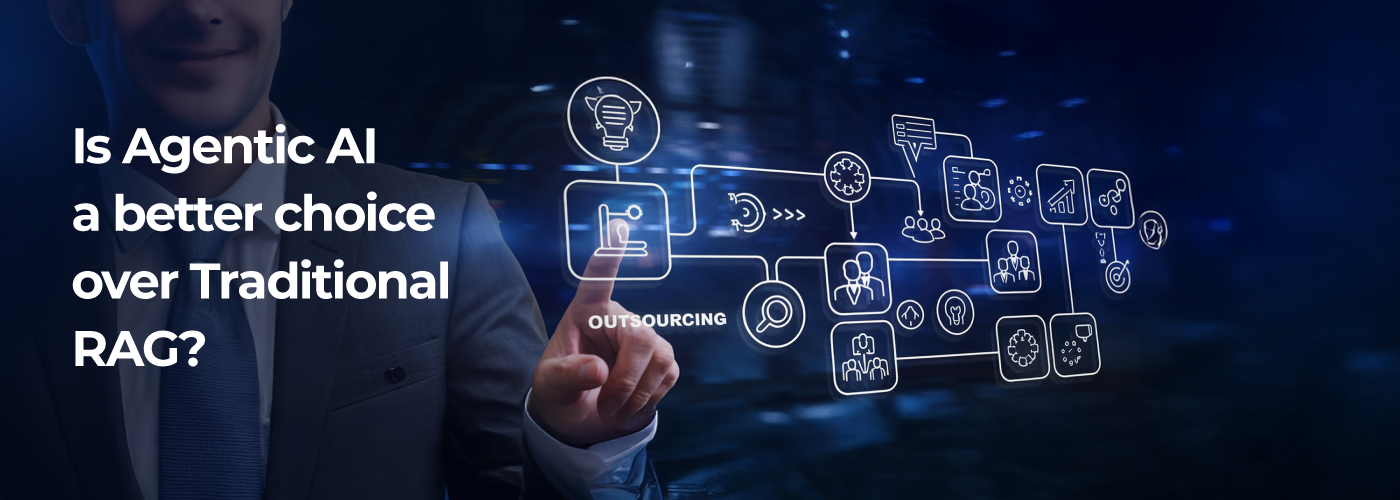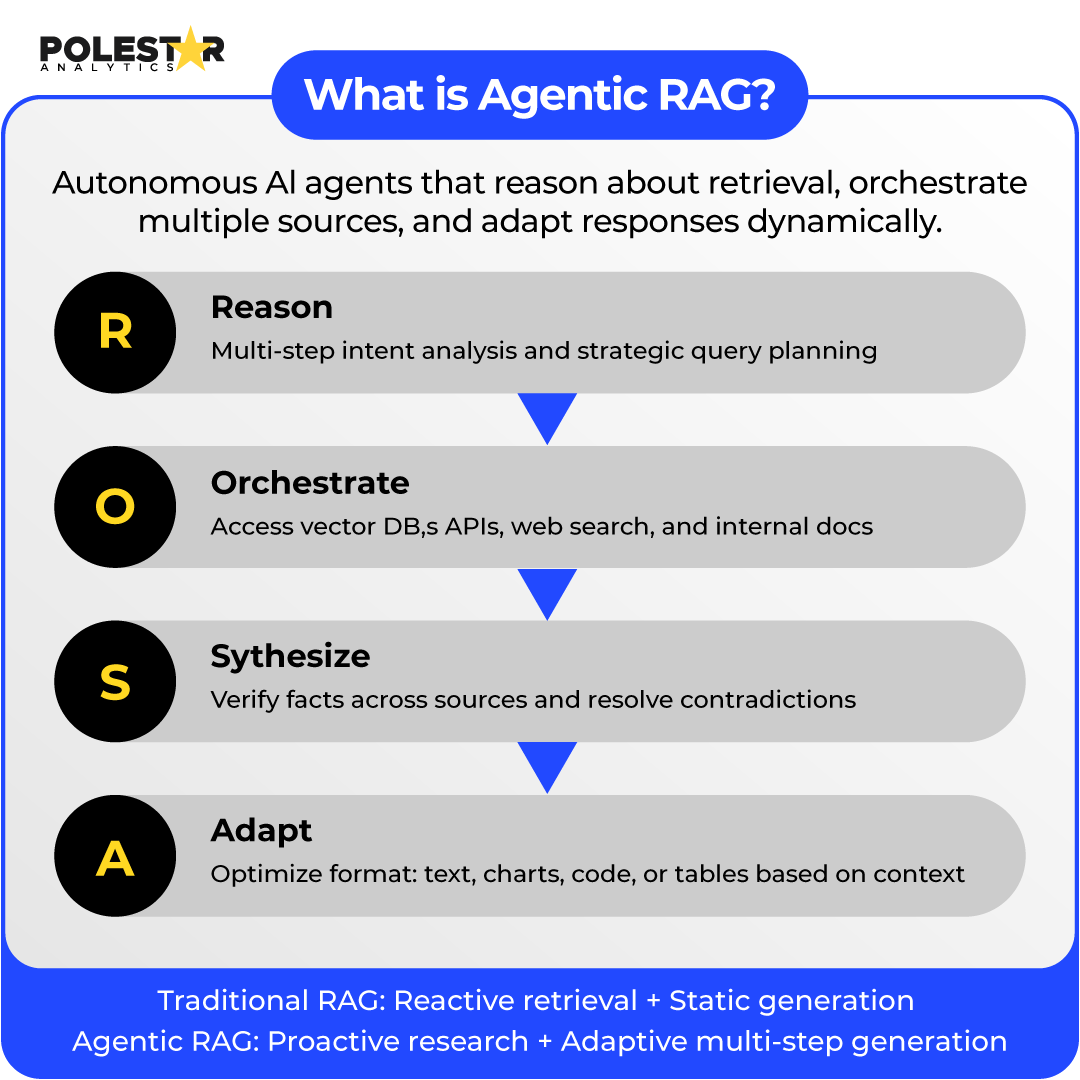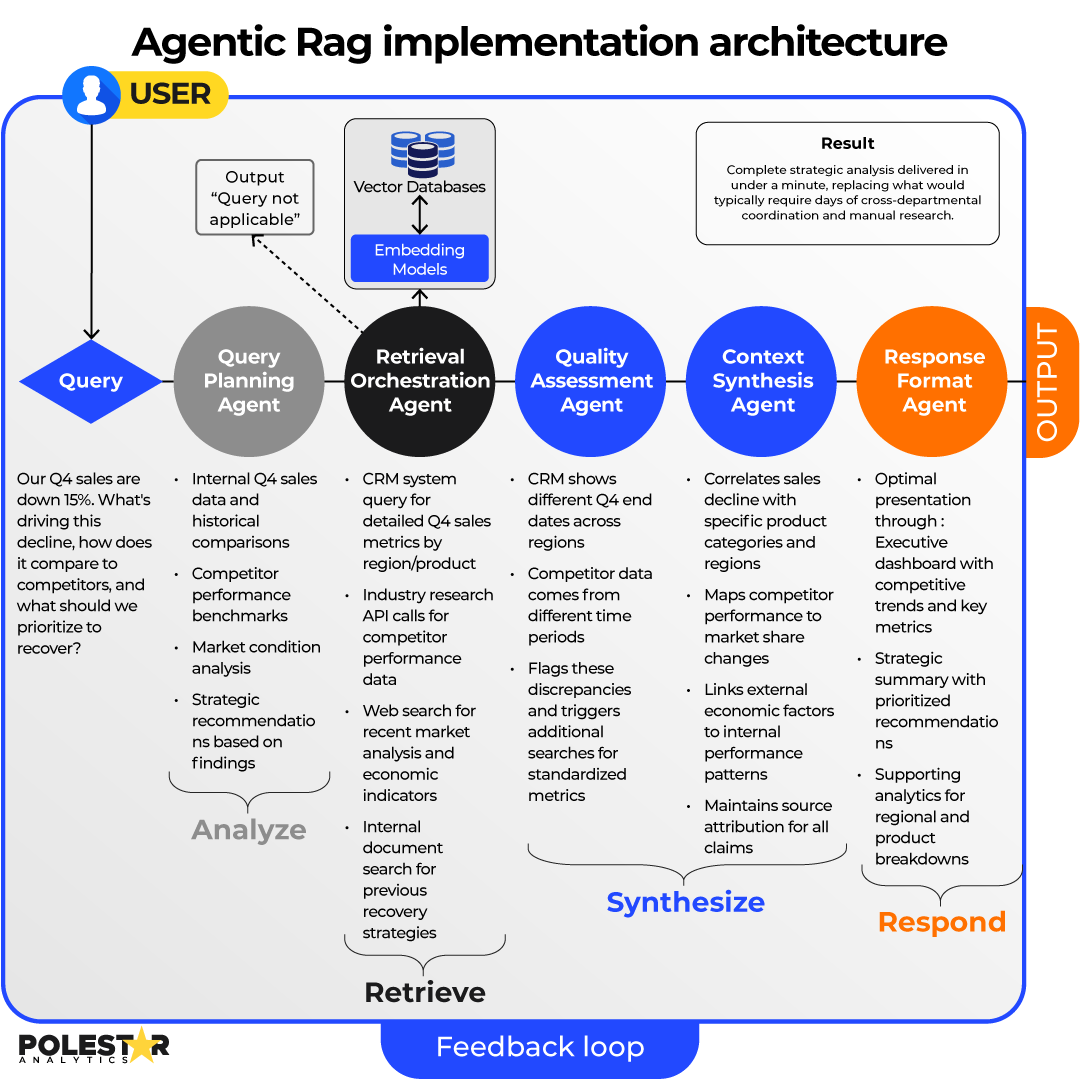
Sign up to receive latest insights & updates in technology, AI & data analytics, data science, & innovations from Polestar Analytics.
Editor's Note: One year down with agentic AI, and now we have Agentic RAG (Retrieval-Augmented Generation). And with what we've seen before... Is this yet another "agentic AI in everything" moment or do we really need this? Let's find out.
If you've worked with enterprise AI systems lately, you've seen both sides: when RAG works, it's powerful—but recent industry research shows 80% of RAG implementations hit critical failures. The 20% that succeed. They've evolved beyond traditional approaches.
RAG which is used to extend LLM capabilities by referencing/connecting it to external knowledge bases for optimizing its outputs, has its limits. You give it a query, it searches its vector database, retrieves relevant chunks, and generates an answer. For straightforward lookups, this works beautifully.
But what happens when your query needs information from three different systems? Or when the first search results aren't quite right and you need to dig deeper? Or when you need to decide on the best way to represent the answer (text explanation, generated chart, or code snippet) based on your query context?
In such cases, traditional RAG just stops. It can't adapt, think beyond its initial search, or choose how to present information.
This is where Agentic RAG takes it to the next level.
Agentic RAG combines autonomous AI agents with retrieval-augmented generation to create systems that actively decide what information to retrieve, from which sources, and how to synthesize results.
So instead of following a rigid "query → search → generate" pipeline, agents actively reason about what to retrieve, from where, and how to piece it together.

Agentic RAG is not only about searching, but also about reasoning.
Agents break down complex questions into searchable indexes for vector embedding, decide which sources to hit (vector databases, APIs, web search, internal docs), cross-reference findings across multiple systems, and even choose which LLM to use based on task complexity.
The agents manage the entire retrieval workflow, making strategic decisions at each step rather than following predetermined paths.
And to understand why this matters, let's look at how these approaches handle real enterprise queries.
| Component | Traditional RAG | Agentic RAG |
|---|---|---|
| Query Processing | Keyword matching and embedding similarity | Multi-step intent analysis with strategic planning |
| Information Sources | Predetermined vector database | Multimodal orchestration (vector DB, APIs, web, docs) |
| Failure Handling | Returns whatever found (might hallucinate) | Implements alternative strategies, query refinement |
| Context Management | Fixed vector chunk injection | Intelligent synthesis with conflict resolution |
| Response Adaptation | Text-only output | Format optimization based on information type (text, charts, code, tables) |
To sum it up in one line - Traditional RAG is " reactive retrieval + static generation"
Agentic RAG is "proactive autonomous research + adaptive, multi-step response generation
The intelligence behind agentic RAG comes from how it reimagines each stage of information processing. Where traditional RAG applies one-‘size’-fits-all approaches, agentic systems adapt their strategy based on content type and query complexity.
If relevant information doesn't exist, agents communicate that clearly instead of hallucinating or generating plausible-sounding but incorrect responses.
These technical capabilities are orchestrated by specialized agents, each handling specific aspects of the retrieval and analysis process.
Let’s see how these agents collaborate on a real business query.

What’s happening here is that instead of sequential search and response generation, five specialized agents coordinate simultaneously to investigate the business crisis from multiple angles, validate information quality, synthesize insights across systems, and deliver comprehensive intelligence in the format executives need—transforming a complex multi-week research project into a few minutes automated analysis.
Why this matters?
RAG Market Explosion
RAG market growing from $1.3 billion in 2024 to projected $74.5 billion by 2034 at 49.9% CAGREnterprise Deployment
Document retrieval leads RAG adoption with 33.5% market share, while cloud deployment dominates with 75.9% shareHealthcare leading adoption
Healthcare sector accounts for 36.61% of RAG implementations, followed by content generation at 34.61%Agentic Evolution
Enterprise RAG predictions show agentic workflows becoming the "next wave of hype" for complex business processesIndustry Perspective-
It's important to note that agentic RAG isn't here to replace traditional RAG—it builds on what traditional systems have already proven works. The foundational vector search, embedding techniques, and retrieval mechanisms remain the same. Agentic RAG simply adds intelligent orchestration on top, which is why this market growth matters for the agentic evolution.
By now you know a few of the major advantages that Agentic RAG provides likes multi-system orchestration, real-time data processing, and intelligent response formatting—but that's not all.
Check out our implementation 5 step implementation blueprint that helps you get actual business results
Get Agentic AI FrameworkYes. Most enterprises adopt a hybrid agentic RAG architecture by layering it on top of traditional RAG. A router decides whether a query should use traditional RAG (for simple document retrieval) or agentic RAG workflows (for multi-source, complex queries). There’s no need to rip and replace existing systems.
At Polestar Analytics, data governance and security are not bolt-on—they’re embedded in the agentic RAG architecture. Our 1Platform manages overall data decisions and solutions, maintaining encrypted, governed working copies so raw systems remain fully protected. Agenthood AI executes the agentic RAG workflow with strict authentication, role-based authorization, and audit trails, making every agent action traceable. This ensures that agentic retrieval augmented generation is enterprise-ready, delivering rich multi-source insights while maintaining trust, compliance, and control.
The biggest hurdles are agent coordination complexity and cost management. Traditional RAG offers predictable costs and easier debugging, while an agentic RAG workflow introduces variable costs and more moving parts. Teams often underestimate the effort required to set quality thresholds and define agent decision boundaries. We recommend a phased approach—starting with discovery workshops to map your data sources, set clear agent roles, and define performance metrics—before scaling to a full agentic RAG system.
That said, current agentic RAG is still in early stages (and has limitations). It costs more, debugging multi-agent workflows is complex, and coordination can fail. But this technology is moving fast.
Multimodal processing is the next big leap—handling text, audio, video, and images in unified workflows instead of separate systems We're talking about predictive intelligence that spots customer churn patterns before satisfaction surveys even show problems. Industry-specific agents that understand healthcare regulations or financial compliance frameworks without needing generic training approaches.
The use cases are expanding as fast as the development. Platforms like Agenthood.ai are making these capabilities accessible without months of custom engineering work. What used to require dedicated development teams now gets deployed in weeks.
The technology exists. The platforms are ready. What's your move?
About Author

Information Alchemist
Without data you are just another person , with an opinion.